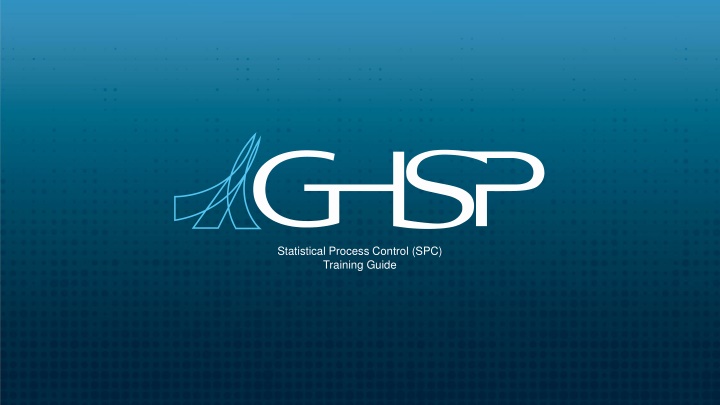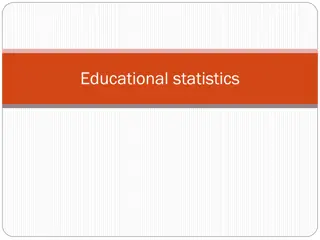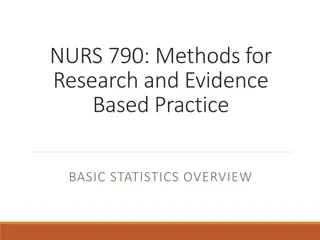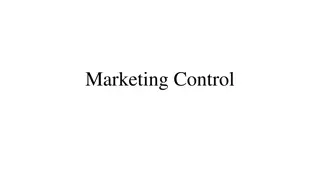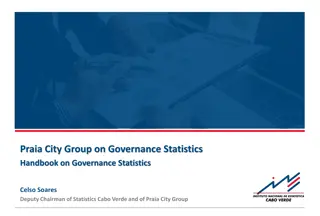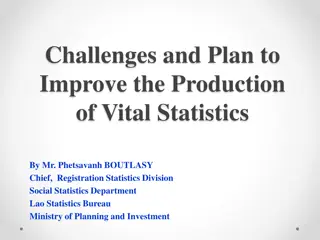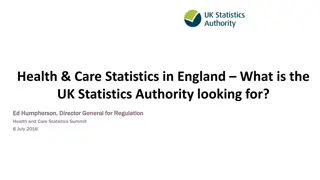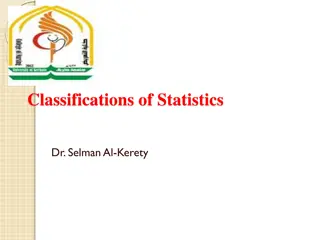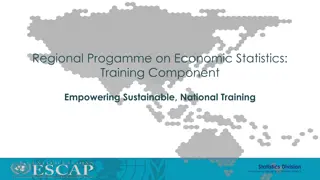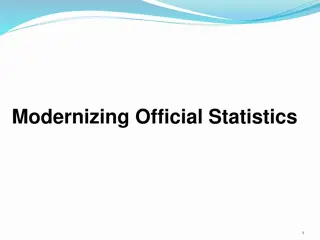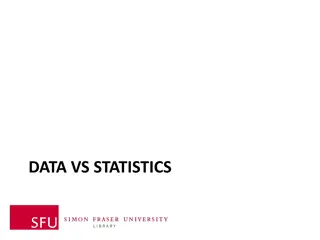Importance of Data and Statistics in Process Control Training
Data is crucial in making informed decisions and taking action. Without data collection, understanding processes and products becomes difficult, leading to a lack of control over outcomes. Proper data analysis is essential for continuous improvement and meeting customer needs. Statistics play a vital role in describing and predicting process/product outcomes, emphasizing the importance of data accuracy and measurement systems. Utilizing statistical methods enables effective process control and quality management.
Download Presentation

Please find below an Image/Link to download the presentation.
The content on the website is provided AS IS for your information and personal use only. It may not be sold, licensed, or shared on other websites without obtaining consent from the author.If you encounter any issues during the download, it is possible that the publisher has removed the file from their server.
You are allowed to download the files provided on this website for personal or commercial use, subject to the condition that they are used lawfully. All files are the property of their respective owners.
The content on the website is provided AS IS for your information and personal use only. It may not be sold, licensed, or shared on other websites without obtaining consent from the author.
E N D
Presentation Transcript
Statistical Process Control (SPC) Training Guide GHSP Confidential
What is data? Data is factual information (as measurements or statistics) used as a basic for reasoning, discussion or calculation. (Merriam- Webster Dictionary, m-w.com) What does this mean? Data allows us to make educated decisions and take action! GHSP Confidential
Why is Data Important? If we don t collect data about a process then what? Without data we don t understand the process / product So what? Without understanding of the process / product we can t control the outcome Is it important to control the outcome? When you can t control the outcome you are dependent on chance. You may have a good outcome, you may not. Without data collection you may not know either way. GHSP Confidential
Use of Data I m not collecting data because its non value add. Without data collection there is no way to identify problems, continuously improve or ensure you are meeting the voice of the customer. I m collecting data, but not looking at it. Is that okay? No, the collection of data without analysis is a bigger waste than not collecting data in the first place. What should I be doing with the data? GHSP Confidential
DATA Statistics Information that can be understood and acted on. GHSP Confidential
What are Statistics A branch of mathematics dealing with the collection, analysis, interpretation and presentation of masses of numerical data (Merriam-Webster Dictionary, m-w.com) What does this mean? Once data is collected we can use appropriate statistical methods to describe (understand) our process / product and control (predict) the process / product outcome GHSP Confidential
Statistics Allow us to Describe our process / product Control (predict) process / product outcomes Sample (125 Pieces) Population (All Product) GHSP Confidential
Important Notes 1. Statistical conclusions require useful data We need to measure the right thing Determining what data to collect and how to collect it are important steps in the APQP / continuous improvement process 2. We need to have confidence the data collected is accurate A good measurement system is required to collect data Be sure the measurement system analysis (MSA) is acceptable before collecting data There is a separate training available for MSA 3. Reduce / Eliminate Waste Data that doesn t provide useful information drives waste We want to gain the most useful information from the least amount of data possible! GHSP Confidential
Types of Data Variable Data (Continuous Data) Measurements on a continuous scale Examples Product Dimensions Weight Time Cost Process parameters (cutting speed, injection pressure, etc.) Attribute Data (Discrete Data) Data by counting Examples Count of defective parts from production Number of chips on a painted part GHSP Confidential
Types of Attribute Data Binomial Distribution Pass / Fail (PPM) Number of defective bezels Number of defective castings Poisson Distribution Number of defects (DPMO) Number of defects per bezel Number of defects per casting GHSP Confidential
Which Type of Data is Better? Variable Data Attribute Data Pros: Provides useful information with smaller sample sizes Can identify common cause concerns at low defect rates Can be used to predict product / process outcomes (trends) Very useful for continuous improvement activities (DOE, Regression analysis, etc.) Pros: Very easy to obtain Calculations are simple Data is usually readily available Good for metrics reporting / management review Good for baseline performance Cons: Data collection can be more difficult, requiring specific gauges or measurement methods Analysis of data requires some knowledge of statistical methods (Control charting, Regression analysis, etc.) Cons: Data collection can be more difficult, requiring specific gauges or measurement methods Analysis of data requires some knowledge of statistical methods (Control charting, Regression analysis, etc.) GHSP Confidential
Introduction to Statistics Goal: 1. Define basic statistical tools 2. Define types of distributions 3. Understand the Central Limit Theorem 4. Understand normal distributions GHSP Confidential
Definitions Population: A group of all possible objects Subgroup (Sample): One or more observations used to analyze the performance of a process. Distribution: A method of describing the output of a stable source of variation, where individual values as a group form a pattern that can be described in terms of its location, spread and shape. GHSP Confidential
Measures of Data Distribution Measures of Location Mean (Average) The sum of all data values divided by the number of data points Mode The most frequently occurring number in a data set Median (Midpoint) Measures of Spread Range The difference between the largest and smallest values of a data set Standard Deviation The square root of the squared distances of each data point from the mean, divided by the sample size. Also known as Sigma ( ) GHSP Confidential
Distribution Types Discrete Binomial Poisson Continuous Normal Exponential Weibull Uniform GHSP Confidential
Central Limit Theorem The Central Limit Theorem is the basis for sampling and control charting (of averages). There are 3 properties associated with the CLT; 1. The distribution of the sample means will approximate a normal distribution as the sample size increases, even if the population is non-normal 2. The average of the sample means will be the same as the population mean 3. The distribution of the sample means will be narrower than the distribution of the individuals by a factor of 1 ?, where n is the sample size. GHSP Confidential
CLT Property 1 The distribution of the sample means of any population will approximate a normal distribution as the sample size increases, even if the population is non-normal. Population Population Population Population Because of this property control charts (for averages) is based on the normal distribution. Distribution of sample means from any population GHSP Confidential
The Normal Distribution 50% 50% 1 = 2 = 3 = 68.3% 95.4% 99.7% 2% 14% 34% 34% 14% 2% -3 -2 -1 0 +1 +2 +3 GHSP Confidential
Process Capability Process Capability GHSP Confidential
Process Capability Goal Understand process capability and specification limits Understand the procedure of calculating process capability Understand Cp, Cpk, Pp and Ppk indices Estimating percentage of process beyond specification limits Understanding non-normal data Example capability calculation GHSP Confidential
Specification Limits Individual features (dimensions) on a product are assigned specification limits. How do we determine a process is able to produce a part that meets specification limits? Process Capability! LSL USL GHSP Confidential
Process Capability and Specification Limits Process capability is the ability of a process to meet customer requirements. USL LSL USL LSL Acceptable capability Product outside of spec limits GHSP Confidential
Calculating Process Capability GHSP Confidential
Determine Stability All sample means and ranges and in control and do not indicate obvious trends GHSP Confidential
Determine Normality Placing all data in a histogram may be used to help determine normality. If the data represents a normal curve. GHSP Confidential
Determine Normality A more statistical method is to use the Anderson Darling test for normality In Minitab go to: Stat > Basic Statistics > Normality Test Select Anderson Darling and click ok GHSP Confidential
Interpreting Normality The p-Value must be greater than or equal to 0.05 to match the normal distribution. GHSP Confidential
Process Indices Indices of process variation only, in regard to specification; Cp and Pp Indices of process variation and centering combined, in regard to specification; Cpk and Ppk GHSP Confidential
Note Before calculating capability or performance indices we need to make sure of a couple of things! 1. The process needs to be stable (in control) 2. The process needs to be normal 3. A completed MSA needs to prove the measurement system is acceptable If the above items are not met understand the results of the capability studies may be inaccurate. Also, per the AIAG PPAP manual (4th Edition) if the above items are not met corrective actions may be required prior to PPAP submittal. GHSP Confidential
Cp Overview ???? ?? ????????????=????? ?? ???????? ????????? Cp = Potential Process Capability = ????? ?? ??????? This index indicates potential process capability. Cp is not impacted by the process location and can only be calculated for bilateral tolerance. GHSP Confidential
Cp Calculation Subgroup Size d2 Cp = ??? ??? =??? ??? 6 2 1.128 6?? ? ?2 3 1.693 4 2.059 5 2.326 Where: 6 2.534 USL = Upper specification limit LSL = Lower specification limit ? = Average Range d2 = a constant value based on subgroup sample size 7 2.704 8 2.847 9 2.970 10 3.078 GHSP Confidential
Interpreting Cp Garage Door Width <1 Car 1 2 LSL USL Cp = Number of times the car (distribution) fits in the garage (specification limit) GHSP Confidential
Cpk Overview Cpk is a capability index. It takes the process location and the capability into account. Cpk can be calculated for both single sided (unilateral) and two sided (bilateral) tolerances. For bilateral tolerances Cpk is the minimum of CPU and CPL where: CPU = ??? ? 3?? 3 ?2 Where: ? = Process average USL = Upper specification limit LSL = Lower specification limit ? = Average Range d2 = a constant value based on subgroup sample size ? ?2 is an estimate of the standard deviation ??? ? ? ? ??? 3?? ? ??? ? ?2 and CPL = = = 3 Note that GHSP Confidential
Cpk Example GHSP is provided a machined casting with a hole diameter of 16.5 1.0mm. Subgroup Size d2 2 1.128 3 1.693 The supplier has collected 25 subgroups of 5 measurements and wants to determine the process capability. With a subgroup size of 5 d2 is 2.326 (table to right). 4 2.059 5 2.326 6 2.534 If the process average ( ?) is 16.507 and the average range ( ?) is 0.561, then the Cpk is calculated as follows: 7 2.704 8 2.847 17.5 16.507 0.561 2.326 16.507 15.5 0.561 2.326 = Minimum CPU = , CPL = 9 2.970 3 3 10 3.078 = Minimum CPU = 1.372 , CPL =1.392 = 1.372 GHSP Confidential
Cp / Cpk Review Cp indicates how many process distribution widths can fit within specification limits. It does not consider process location. Because of this it only indicates potential process capability, not actual process capability. Cpk indicates actual process capability, taking into account both process location and the width of the process distribution. GHSP Confidential
Pp Overview This index indicates potential process performance. It compares the maximum allowable variation as indicated by tolerance to the process performance Pp is not impacted by the process location and can only be calculated for bilateral tolerance. Pp must be used when reporting capability for PPAP Where: = Standard deviation USL = Upper specification limit LSL = Lower specification limit Pp = ??? ??? 6?? GHSP Confidential
Pp and Cp Pp Cp takes into account within subgroup variation (average range) Pp takes into account between subgroup variation GHSP Confidential
Ppk Overview Ppk is a performance index. It indicates actual process performance, taking into account both process location and overall process variation. Ppk shows if a process is actually meeting customer requirements. Ppk can be used for both unilateral and bilateral tolerances. Ppk must be used when reporting capability for PPAP GHSP Confidential
Ppk Calculation Ppk is the minimum of PPU and PPL where: PPU = ??? ? ? ??? 3?? and PPL = 3?? Where: ? = Process average USL = Upper specification limit LSL = Lower specification limit = Standard deviation GHSP Confidential
Pp / Ppk Review Pp indicates how many process distribution widths can fit within specification limits. It does not consider process location. Because of this it only indicates potential process performance, not actual process performance. Ppk indicates actual process performance, taking into account both process location and the width of the process distribution. GHSP Confidential
A Few Notes Cpk will always be smaller than Cp, unless the process is centered. If the process is centered the two value will be the same. Ppk will always be smaller than Pp, unless the process is centered. If the process is centered the two values will be the same. Cp and Pp cannot be calculated for unilateral tolerances. Cpk and Ppk can be calculated for both unilateral and bilateral tolerances. Often, short term capability will be calculated using Cp and Cpk. This is because these indices use calculation tells us how good a process could potentially be at its best performance. Pp and Ppk uses the actual (overall or between subgroup) standard deviation to calculate performance. As such, when reporting capability use Pp and Ppk. ? ?2 to estimate standard deviation, which is a calculation of within subgroup variation. This GHSP Confidential
Cpk and Ppk Compared These two data sets contain the same data. The top data set is from an immature process that contains special cause variation. The bottom data set has the same within group variation, but has between group variation removed. The bottom data set shows a process that is in statistical control. This example may be found in the AIAG SPC (Second Edition) Manual on page 136 GHSP Confidential
Process Indices Review Process Indices Interpretation 1. Cp = 4.01, Cpk = 4.01 Pp = 4.00 , Ppk = 3.99 1. This process is stable and produces almost all parts within specification 2. Significant common cause variation exists 3. Significant special cause variation exists 4. Improvement can be made by centering the process 2. Cp = 0.27, Cpk = 0.26 Pp = 0.25, Ppk = 0.24 3. Cp = 4.01, Cpk = -2.00 Pp = 3.99, Ppk = -2.01 4. Cp = 4.01, Cpk = 4.00 Pp = 2.01, Ppk = 2.00 GHSP Confidential
Estimating Percent Out of Specification To estimate the percentage of product that falls outside of the specification limits we need to compute Zupper and Zlower USL = 182 LSL = 160 For this example assume an average range of 8.4 from a stable process using a sample size of 5 178.6 167.8 189.4 Zlower is the number of standard deviations between the average and the LSL Zupper is the number of standard deviations between the average and the USL GHSP Confidential
Estimating Percent Out of Specification ? ?2 = 8.4 2.326 = 3.6 = USL = 182 LSL = 160 Zupper = ??? ? ? Zupper = 182.0 178.6 = 0.94 3.6 178.6 167.8 189.4 ? ??? ? Zlower = The USL is 0.94 from ? The LSL is 5.17 from ? Zlower = 178.6 160.0 = 5.17 3.6 GHSP Confidential
Estimating Percent out of Specification Next, we need to reference a z table. From the z table we find 0.94, which corresponds to a proportion of 0.1736 USL = 182 LSL = 160 This convert to 17.36% defective or 173,600 PPM 178.6 167.8 189.4 Zupper = 0.94 GHSP Confidential
Understanding Non-Normal Data What happens when data used for capability is not normally distributed? Cp and Pp indices are robust in their accuracy with regards to non-normal data. Cpk and Ppk indices are not robust with regards to non-normal data. Calculating (and making decisions based on) Ppk and Cpk indices assuming normality with non-normal data can be misleading. GHSP Confidential
Understanding Non-Normal Data What do I do if my data is not normal? Gather more data This may or may not be an option given timing and cost. The Central Limit Theorem (covered earlier) states that all population means resemble the normal distribution with larger sample size Transform the data Using either the Box-Cox or Johnson transformations we can transform non-normal data to a near normal form This allows use to accurately calculate Cpk and Ppk indices and the proportion nonconforming Calculate capabilities based on different distributions GHSP Confidential
Box-Cox Transformation The goal of the Box-Cox transformation is to identify a Lambda value ( ). The Lambda value will then be used in the function X to transform the data (X) from a non-normal set into a normal data set. The formula for this transformation is W=X where: -5 5 and = 0 for the natural log transformation = 0.5 for the square root transformation GHSP Confidential
Box-Cox in Practice The Box-Cox transformation can be used in Minitab s capability analysis of normal data. When running a capability study in Minitab select: Stat > Quality Tools > Capability Sixpack > Normal Then select Transform and check Box-Cox power Transformation GHSP Confidential
